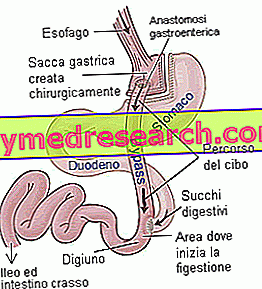Generality
Ferritin is the main iron-depositing protein in cells. Therefore, its concentration in the blood reflects the extent of mineral reserves in the body .

An abnormal level of ferritin in the blood can be an indicator of an underlying disease or a particular condition, such as in the case of deficiencies responsible for anemias.
What is Ferritin
Ferritin is an essential protein for iron storage in the body.
Its structure is formed by a complex of smaller elements (called subunits), which join together to form a kind of shell, inside which the iron is stored.
Ferritin is mainly contained in cells, where it accumulates iron and releases it in case of need, making it quickly usable by the body.
A small part of ferritin is also present transiently in the bloodstream . This proportion is generally proportional to the concentration of the protein present in the tissues.
Ferritin in blood and tissues
Under normal conditions, there is a precise balance between the amount of ferritin present in the various tissues ( deposits ) and plasma ferritin ( in circulation ).
The concentration of the protein in the blood, even if transient, is therefore an excellent indicator of the amount of iron available to the body.
Role in the organism
Ferritin is an iron-protein complex that is found in all tissues, but particularly in the liver, spleen, bone marrow and skeletal muscles. We find small amounts of ferritin also in the plasma, which can be evaluated by the so-called ferritinemia dosage .
This examination is very important, since the concentration of ferritin in the blood reflects the extent of the body's reserves of iron. The primary function of ferritin is in fact to constitute an important deposit of the mineral in the body.
Unlike that bound to a second organic iron-protein compound, called hemosiderin, the iron associated with ferritin is rapidly mobilizable. This means that if the mineral is needed, the body can draw on it easily.
For all these reasons, ferritin values lower than the norm indicate, with some certainty, a state of iron deficiency; they can also constitute a differential diagnosis between iron deficiency anemia (or iron deficiency) and anemia due to other causes.
Why do you measure
The dosage of plasma ferritin (ferritinemia) is mainly used to quantify the iron reserves in the body.
For this, the exam is prescribed, together with the serum iron test and the total iron-binding capacity ( serum transferrin ), in the case of:
- Suspected excess of iron due to : hereditary diseases (such as haemochromatosis), overloading with diet, excessive accumulation (hemosiderosis) etc .;
- Low values of hematocrit and hemoglobin : the level of ferritin in the blood allows early diagnosis of an iron deficiency, which could be the cause of anemia .
Normal values
AVERAGE FERRITINE VALUES IN THE ADULT:
- Women : 20-120 nanograms / mL (20-120 micrograms / L)
- Men : 20-200 nanograms / mL (20-200 micrograms / L)
In the presence of an iron deficiency, serum ferritin is almost always less than 20 micrograms per liter, while in conditions of overload it is also possible to find very high values, close to 5 thousand micrograms per liter.
Physiological changes of ferritin
Depending on the age or the particular situation, there may be some differences in the ferritin values:
- Age : normally, average ferritin levels are slightly higher at birth (400 ng / mL) and around two months of life it reaches around 600 ng / mL. Ferritinemia is lowered, then, during childhood, until reaching adult values during puberty.
- Gender : ferritin values are higher in men, while they are lower in women before menopause.
- Decrease : ferritin levels tend to fall in pregnancy, especially starting from the third month. A decrease in the values found also in people who practice an intense and regular physical activity.
High Ferritin - Causes
High levels of ferritin ( hyperferritinemia ) indicate a possible iron overload in the blood.
This could depend on:
- Excessive introduction of food (diet and supplements) or iatrogenic (specific oral or intravenous - intramuscular drugs);
- Iron accumulation: hemochromatosis, hemosiderosis;
- Chronic infections;
- Leukemia;
- Malignant neoplasms (liver, lung, pancreas, breast and kidney);
- transfusions;
- Hemopathies (acute leukemias and Hodgkin's lymphoma);
- Acute or chronic hepatitis;
- Alcoholism.
Low Ferritin - Causes
The decrease in ferritin values in the blood ( hypoferrithinemia ) indicates that iron reserves are scarce.
Low ferritin levels are found in case of:
- Iron deficiency anemia;
- Chronic hemolytic anemias;
- Nutritional deficiency and reduced absorption (malnutrition, vegetarian diet, strict diet, celiac disease, diarrhea, gastro-intestinal changes);
- Bleeding (trauma, heavy menstrual flow, chronically bleeding hemorrhoids, gastroduodenal ulcers, nosebleeds, covert losses, etc.);
- Pregnancy (in this period iron deposits are reduced to meet the needs of the fetus);
- Rheumatoid arthritis.
How to measure it
Plasma ferritin examination is performed on a venous blood sample, usually taken from the elbow crease.
In the laboratory, the dosage is then performed, that is the measurement of the concentration of the protein in the blood sample collected by the patient.
Preparation
The sample is usually taken in the morning.
The patient can undergo the examination after a fast of at least 3 hours .
Interpretation of Results
The dosage of ferritin in the blood is commonly used to identify states of overload or iron deficiency.
- The normal ferritin values range from 15 to 300 nanograms / ml.
- A high level of ferritin may be due to possible iron overload . This situation can be secondary to genetic diseases (hemochromatosis), excessive accumulation in the organs (hemosiderosis) or increased nutritional intake of the mineral.
If this hypothesis is excluded, all the causes that can determine a non-specific increase will be evaluated: acute and chronic inflammatory states, liver changes, infections, alcoholism and neoplasms. In these conditions, the production of ferritin in the tissues increases (consequently also in the blood) regardless of the size of the iron deposits.
- A low level of ferritin in the blood is considered the earliest indicator of a depletion of mineral deposits. This must be considered especially in the differential diagnosis of iron deficiency anemias (in which the value of ferritin is low) from those with different etiology.
More precisely, a low ferritin (22 ng / ml), associated with altered hemoglobin and hematocrit values, and in the presence of small red blood cells that are less pigmented than normal (microcytic and hypochromic), indicates a iron deficiency anemia (ie caused from iron deficiency).
Another common cause of hypoferrithinemia is an increase in losses or needs (hypermenorrhea, bleeding from the gastro-intestinal tract and pregnancy). Less often, low ferritin levels indicate reduced nutritional intake or serious depletion of plasma proteins, such as in malnutrition.
A more detailed study of iron metabolism also requires the examination of sideremia and transferrin or total iron-binding capacity (TIBC).
Warning! Depending on the type of technique used by the laboratory, ferritinemia values may be slightly different. Therefore, it is preferable to consult the reference intervals indicated for each analysis directly on the report.
Treatment
In case of Low Ferritin
When ferritin is low, but the anemic picture is still not appreciable, the doctor recommends a greater consumption of foods rich in iron: meat, legumes, fish, molluscs, shellfish, dried and fresh fruit [especially citrus fruits, not so much for their content, however modest, of iron, as to ensure the right amount of ascorbic acid to the body (a vitamin, C, important for mineral absorption)].
If iron deficiency is important, it is possible to take iron supplements.
In case of High Ferritin
When ferritin is high, the therapy consists of blood-letting (samples of 350 - 400 ml of blood), which remove the red blood cells (rich in iron) from the body, stimulating it to produce new ones.
The doctor will also prescribe a low-iron diet, possibly associated with chelators (desferrioxamine), which bind and eliminate the mineral through urine.



